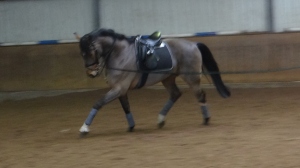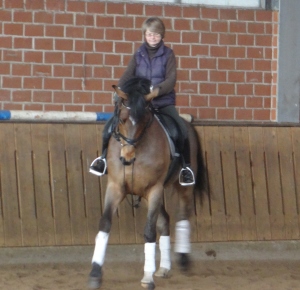Before I say more, let me define what I mean by “balance” for the purposes of this post. I am referring to the riders equilibrium and ability to follow the movements of the horse without unnecessary or involuntary actions.
Happily, on my recent visit to Germany I encountered a horse that really appealed to me.  He was a gelding of good size (1.65 or 1.66), very nice ground covering strides, very elegant with a beautiful neck, friendly and calm on the ground, relatively easy to lunge and had some training, I think to basic M level. Given the fact that he had been out of work (as have I) for a couple of years and was a bit stiff (as was I), this is a guess.
He was a gelding of good size (1.65 or 1.66), very nice ground covering strides, very elegant with a beautiful neck, friendly and calm on the ground, relatively easy to lunge and had some training, I think to basic M level. Given the fact that he had been out of work (as have I) for a couple of years and was a bit stiff (as was I), this is a guess.
Under saddle he appealed to me because he was just difficult enough to be challenging without doing anything against the rider. To be specific he is very electric; that is to say, very reactive (almost over-sensitive) to stimuli, both from the rider and the environment. He is not spooky, but instead is anxious and tries to escape what is for him anything unnerving. As a result he seeks his confidence from the rider, and if the rider is either absent to disruptive, he either takes over or gets very anxious.
Enough about him, let’s get to the issue at hand – Balance. The first thing I discovered on this very active and forward moving horse was that, after my little riding hiatus, my “balance” had mysteriously disappeared. To my horror, I discovered I had no effective seat, and like a rank beginner hung on with my legs. Well, on an electric horse who is highly reactive to the lower leg and spur, there is just on response — a very brisk tour of the arena. Fortunately, a lifetime of riding experience and education kicked in and after a few seconds of surprise, I managed to get my spurs out of his sides and supple his rigid neck and gain some control. Maybe I had lost my seat, but not my mind or learned responses, and I did not try to “pull” him to a stop. So, there I was, two days into my return to “serious” riding and the handwriting was on the wall. I had no balance!
As I have said to students for years, without a solid but supple seat, you cannot have effective legs or a good hand connection. So for me, sitting on an extremely sensitive and reactive horse, who has been trained by a rider with a seat second to none, it was a strong reminder that the rider’s balance is so crucial to the security of the horse. It is something I had taken for granted for so long that at first I felt totally lost.
After a week of riding (well sort of) I began to feel that I could follow the horse and influence him a little from my seat in the rising trot. A few more days of riding, and I started to become a bit more supple and relaxed (suppleness is not coming back as easy as it did when I was 30) and I could follow the canter with my seat instead of rocking my upper body. Sadly, at first, being stiff and out of balance I had to diminish his large gaits somewhat to follow them, but by the fourth week I was able to relax my seat and allow his ground cover in the sitting trot. As a result, by the time I left Germany, the horse was calmer to ride and gave me positive responses to my “intentional” aids. Needless to say, the unbalanced riders gives a lot of “unintentional” aids, and I was no exception.
As I reflect on this humbling experience (nothing is quite like making a fool of yourself in a training stall in Germany) I think of how hard all my students worked and how much progress they made. But I also remember always believing the rider had to learn to use the aids properly in order to keep the horse in equilibrium, or to bring him back to it when he loses it. This I believed was necessary to help the rider maintain his “balance”, as it is obvious that the “horse makes the rider” in a sense. (It is hard to be straight on a crooked horse.) But I must say, one thing I realized with my own loss of balance is this: The rider cannot properly and effectively use the aids without achieving his own balance first, and that means developing a secure seat with independent hands and legs that do not grip, therefore he cannot truly train his horse, or effectively ride a trained one. The only alternative to this is to diminish the responses of the horse so that he reacts to nothing. For me, that is not an option.
Needless to say, this horse literally “shouted” at me to get my act together …. and quickly!!! Fortunately I was able to draw on all my training and experience, and sufficiently recover my balance and find my seat, though it needs to be more solid and effective, to the point where he finally started to trust me. I will be back soon to continue “redeveloping” my riding skills. This horse suits my personality so well, and my goal will be to bring myself to the point where I can produce (or allow) his good expression with mental calmness, both his and mine.


